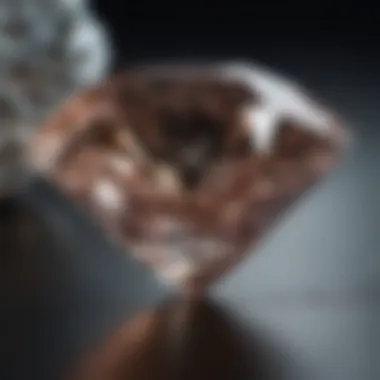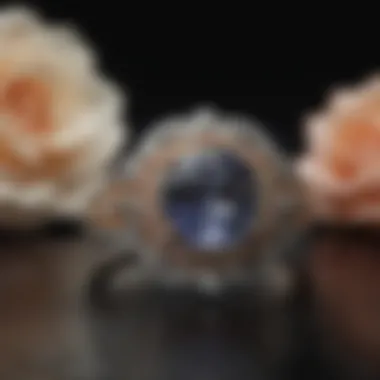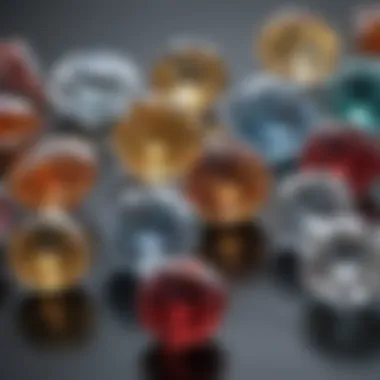The Birthstone for April: Meanings and Characteristics


Intro
April's birthstone, the diamond, stands as a symbol of enduring beauty, strength, and clarity. This gem has captivated humans for centuries, not just for its stunning appearance but also for the historical and cultural meanings that have evolved around it. The diamond's allure extends far beyond its physical properties; it embodies a unique blend of mythology, significance in various cultures, and investment value that commands recognition.
In this article, we will explore the rich tapestry of meanings associated with diamonds, tracing their origins and examining their various forms. Additionally, we will delve into the historical significance of diamonds, looking at ancient uses and cultural interpretations. Through this journey, we aim to provide an insightful perspective for gemstone enthusiasts, collectors, and anyone intrigued by the complexity of this remarkable stone.
Gemstone Overview
Definition and Characteristics
Diamonds are a type of carbon crystal that form under intense pressure and temperature deep within the Earth. Their unique molecular structure gives them several notable characteristics:
- Hardness: Diamonds are the hardest known natural material on the Mohs scale, rated at a 10, making them highly resistant to scratching.
- Brilliance: The high refractive index of diamonds contributes to their exceptional sparkle and fire, resulting in mesmerizing displays of light.
- Variety: While most diamonds are colorless, they can come in a range of hues: blue, yellow, pink, and even green, due to various impurities in their structure.
Classification of Gemstones
Gemstones, including diamonds, can be classified based on various criteria:
- Precious vs. Semi-Precious: Diamonds are categorized as precious gemstones, alongside rubies, sapphires, and emeralds.
- Natural vs. Synthetic: Natural diamonds form in nature over millions of years, whereas synthetic diamonds are created in labs to possess similar physical attributes.
- Color and Clarity: The GIA (Gemological Institute of America) grades diamonds based on their color, clarity, cut, and carat weight, commonly known as the "Four Cs."
Historical Significance
Ancient Uses and Cultural Importance
Throughout history, diamonds have captivated diverse civilizations. In ancient India, diamonds were considered sacred and were often associated with the divine. They were believed to possess protective qualities; warriors adorned their swords with diamonds to symbolize invincibility.
In other cultures, such as the Romans, diamonds were connected with love and commitment. This association continues today, particularly within the engagement ring market, where diamonds symbolize unbreakable bonds and lasting relationships.
Myths and Legends Surrounding Gemstones
Diamonds have inspired numerous myths and legends over the years. Ancient Greeks believed that diamonds were tears of the gods, reflecting divine illumination. Meanwhile, in medieval Europe, people thought diamonds could provide invulnerability and good fortune to their wearers.
"Diamonds are a girl's best friend." This famous quote highlights the enduring legacy and cultural status that diamonds maintain in modern society.
Prolusion to Birthstones
Birthstones have captivated human attention for centuries. They represent more than mere jewels. In many cultures, each gemstone is believed to hold unique powers and significance, which can vary from luck to protection. This article examines the birthstone for April, focusing on its unique characteristics and meanings. Understanding the foundations of birthstones helps appreciate their special role in culture and tradition.
Historical Overview of Birthstones
The concept of birthstones dates back to ancient history. The origins trace back to the Gemstones of Aaron mentioned in the Bible, where twelve stones represented the twelve tribes of Israel. Over time, these stones became associated with the months of the year. In 1912, the American National Retail Jewelers Association formalized the list of birthstones, creating a guide that is still widely referenced today.
Birthstones were often linked to astrological significance and were used in talismans and amulets throughout history. Ancient civilizations, such as the Egyptians and the Romans, believed wearing a specific stone during its corresponding month would provide benefits or protection. This connection between time and stones highlights the human desire to find meaning in what we wear and the forces that shape our lives.
Significance of Birthstones in Various Cultures
Birthstones are significant across diverse cultures. In Hindu tradition, each month has specific gems that correspond with planets and deities. For example, the month of April coincides with diamonds, which are believed to enhance relationships and provide clarity of thought.
In Western cultures, birthstones are commonly used as personal gifts. They symbolize love and devotion, particularly in jewelry such as rings and necklaces. Many couples choose to personalize wedding or engagement rings with the partner's birthstone, signifying a deeper connection and cherished bond.
- Symbolic Meanings: Birthstones carry deep meanings in various traditions, making them ideal choices for gifts.
- Cultural Beliefs: Different cultures attach various attributes to stones, impacting how they are viewed and utilized in jewelry design.
Ultimately, birthstones act as a bridge between personal identity and cultural heritage. Their enduring presence in jewelry and tradition underscores how gemstones transcending mere aesthetics hold significant value in human society.


The Birthstone for April: The Diamond
The diamond, renowned for its brilliance and hardness, is a gem that holds significant meaning as the birthstone for April. Understanding the diamond's multifaceted characteristics can enhance its appreciation among those born in this month and those who collect or gift it. As we explore the diamond, we will uncover its rich history, cultural relevance, and its unique physical properties that set it apart from other gemstones. By delving into this topic, we align ourselves with the values of clarity, strength, and eternity that diamonds symbolize.
Prolusion to Diamonds
Diamonds are formed under immense pressure and heat deep within the Earth's mantle. Made primarily of carbon atoms, they crystallize in a cubic structure, giving them their renowned hardness. This unique formation process contributes not only to the diamond's durability but also to its remarkable beauty and desirability. The appearance of diamonds can vary widely, influenced by factors such as cut, color, clarity, and carat weight. Each of these elements plays a significant role in determining the gem's value and visual appeal.
The allure of diamonds extends beyond their physical traits. They have a rich historical context that makes them a coveted choice for personal adornment and investment alike.
Historical Significance of Diamonds
Diamonds boast a long and storied past dating back to ancient civilizations. They were first discovered in India over 2,000 years ago and were prized for their rarity and beauty. Historically, diamonds have been associated with wealth and power. Royalty frequently adorned themselves with diamond jewelry to display their status.
In medieval Europe, diamonds were believed to have protective qualities, warding off evil and bringing good fortune. With the rise of the diamond trade through various regions, most notably during the 19th century, diamonds became increasingly accessible. The discoveries of diamond mines in places like South Africa transformed diamonds from purely symbols of status to items of monetary investment and personal significance.
Moreover, diamonds feature prominently in engagements and weddings, symbolizing unbreakable bonds and commitment. Their presence in various cultures and time periods illustrates their continued importance and timeless appeal.
Cultural Representations of Diamonds
Across cultures, diamonds hold various symbolic meanings. In Western contexts, they are seen as symbols of love and fidelity, cementing their status as choice stones for engagement rings. This tradition reflects society's values of enduring love and commitment.
In contrast, in some Eastern cultures, diamonds are associated with wisdom and enlightenment. They are often featured in spiritual practices and used as talismans for protection and clarity of mind. The differences in interpretation highlight how the diamond transcends geographical and cultural boundaries, symbolizing both emotional and metaphysical ideals.
Engagement with diamonds also appears in literature and art, where they represent unattainable beauty and the passage of time. Their multifaceted nature invites people to reflect on various aspects of existence, from love to power and everything in between.
Diamonds are more than just gemstones; they are vessels of history, culture, and emotion encapsulated in their stunning brilliance.
Overall, the diamond as April's birthstone is rich in meaning and complexity. Each layer of its significance encourages reflection and appreciation, making it a fitting symbol for those born in this month.
Physical Properties of Diamonds
The physical properties of diamonds play a crucial role in understanding why this gemstone has captured the fascination of many for centuries. Diamonds are commonly known for their beauty and allure, but their physical characteristics are equally important. These properties not only dictate their aesthetic value but also their functionality and longevity as a precious stone in jewelry. The composition and characteristics provide insight into the diamond's durability and brilliance, essential factors for collectors and enthusiasts alike.
Chemical Composition of Diamonds
Diamonds are composed entirely of carbon atoms arranged in a crystalline structure. This unique arrangement is what grants diamonds their remarkable hardness. In terms of chemistry, when carbon atoms bond together under extreme heat and pressure deep within the Earth, they form the diamond. This strong covalent bonding results in the hardest known natural material. The purity of the carbon used in its formation affects the diamond's clarity, which in turn impacts its value and desirability.
Gemological Characteristics
Gemological characteristics describe the specific traits that discern diamonds from other gemstones. Two key aspects are hardness and light performance.
Hardness and Durability
The hardness of diamonds is measured using the Mohs scale, where they achieve a rating of 10. This means they can withstand scratches from almost any other material. This resilience contributes significantly to the diamond's appeal. As a choice for engagement rings and other jewelry, diamonds resist wear and tear over time.
However, while diamonds are exceptionally hard, they are not indestructible. A diamond can chip or break if subjected to strong impact at certain angles. Therefore, while their durability is an advantage, care must be taken during wear and handling. This blend of hardiness and care necessity adds layers to their ownership experience.
Light Performance and Brilliance
Light performance is a defining characteristic of diamonds, heavily influencing their perceived value. Light enters a diamond and is refracted, creating that sought-after sparkle. The way a diamond interacts with light is often referred to as brilliance.
The cut of a diamond significantly determines its light performance. A well-cut diamond maximizes the light that reflects from its surfaces. Poor cuts can lead to dullness, diminishing the visual appeal. This feature not only emphasizes the aesthetic enjoyment of wearing diamonds but also affects their market value.


In summary, the physical properties of diamonds encompass a range of elements from chemical structure to gemological characteristics. These factors not only underscore the diamond's desirability but also its practicality as a lasting investment and symbol of enduring love.
Metaphysical Properties of Diamonds
Diamonds, often lauded for their aesthetic beauty, carry significant metaphysical properties that resonate with individuals on deeper levels. This section focuses on the unique spiritual attributes, healing powers, and profound symbolism associated with diamonds. Understanding these properties may enhance one's appreciation for diamonds beyond their visual allure, allowing for a richer connection to this remarkable gemstone.
Spiritual Significance
The spiritual significance of diamonds is deeply rooted in various cultures and belief systems. Many view diamonds as powerful tools for inner clarity and enlightenment. The transparent quality of diamonds is often seen as a metaphor for purity and truth. People who resonate with diamonds may do so because they seek clarity in their lives or wish to dispel confusion.
Diamonds are also believed to enhance one's spiritual awareness. Individuals often wear diamond jewelry during meditation or spiritual practices. Their energy is thought to amplify intentions, making the connection to the higher self stronger. People believe that diamonds open the mind to new possibilities and insights, thus enhancing spiritual journeys.
Healing Properties
Diamonds are not just beautiful; they are also attributed with various healing properties. Some holistic practitioners assert that diamonds can aid in emotional healing. They are thought to help release negative energy and facilitate emotional balance. People often use diamonds to support the healing of the heart, both physically and emotionally. Their energy is believed to foster forgiveness, self-love, and resilience in the face of challenges.
Moreover, diamonds are thought to aid in physical healing as well. They are often regarded as stones of strength and vitality, believed to enhance overall health. Their purported ability to amplify energy may help with energy blockages in the body. People interested in holistic healing modalities may incorporate diamonds into their healing practices.
Symbolism of Strength and Clarity
Diamonds epitomize strength and clarity, serving as symbols that reflect resilience in various contexts. The hardness of diamonds, ranked highest on the Mohs scale, symbolizes durability and unyielding strength. In life, individuals often draw parallels between the properties of diamonds and their own journey through adversity. This makes diamonds popular choices for commemorative jewelry such as engagement rings, symbolizing enduring love and commitment.
Additionally, diamonds represent clarity in both thought and vision. They are seen as catalysts for personal growth, allowing individuals to confront and navigate complexities in life. Through their clarity, diamonds provide inspiration for leading an authentic and honest life.
In summary, diamonds are not only admired for their physical beauty; they are also venerated for their metaphysical properties that promote spiritual awareness, emotional healing, and symbolize strength and clarity. This understanding expands the narrative surrounding diamonds, making them more than mere adornments.
Caring for Your Diamond
Caring for a diamond is crucial for maintaining its beauty and value over time. Diamonds, despite their hardness and durability, can accumulate dirt, oils, and scratches. Understanding how to properly maintain a diamond can ensure it retains its brilliance and longevity.
Cleaning Techniques
Regular cleaning is essential for preserving the clarity and shine of diamonds. Here are some effective cleaning techniques:
- Soap and Water Solution: Create a mixture of warm water and mild dish soap. Soak the diamond jewelry for around 20 to 30 minutes, then gently scrub with a soft toothbrush. Ensure that you reach under the stone, where dirt often hides.
- Commercial Cleaners: There are many commercial jewelry cleaners designed specifically for diamonds. Select a product from a reputable brand. Follow the instructions carefully to avoid any damage.
- Ultrasonic Cleaners: These machines use high-frequency sound waves to remove dirt. While effective, ultrasonic cleaners may loosen stones, so use them cautiously.
"A clean diamond sparkles brighter, reflecting both light and attention."
Maintaining a regular cleaning schedule, ideally every few weeks, can prevent buildup of dirt and residue.
Storage Recommendations
Proper storage is equally important to protect diamonds from scratches and damage. Here are some best practices:
- Individual Storage: Always store diamond jewelry separately to avoid scratching. Use soft pouches or dedicated compartments in your jewelry box.
- Temperature and Humidity Control: Diamonds do best in a controlled environment. Extreme temperatures or fluctuating humidity can damage settings.
- Avoid Contact with Chemicals: Keep diamonds away from harsh chemicals found in household cleaners, swimming pools, or hot tubs. These can weaken the settings or tarnish the metal.
By adhering to these cleaning and storage recommendations, you can keep your diamond as radiant as the day you acquired it, ensuring it remains a cherished piece for years to come.
Investing in Diamonds
Investing in diamonds has become an increasingly intriguing option for both seasoned investors and newcomers alike. Unlike volatile assets, diamonds offer a unique proposition with a mixture of aesthetic value and potential financial gain. The importance of investing in diamonds, particularly the diamond designated for April, stems from its historical significance and cultural resonance as well as its tangible properties, making it an alluring choice.
Diamonds are not just beautiful; they hold inherent value that can appreciate over time. Historically, diamond prices have demonstrated resilience against economic fluctuations. The demand for high-quality stones often remains stable, even during uncertain financial times. This characteristic makes diamonds a potentially sound investment, especially for those looking to diversify their portfolios.


However, before entering the diamond market, certain factors must be considered. Understanding one’s own objectives is crucial. Some investors may seek quick returns, while others prefer long-term appreciation. Knowing the type of investment — whether purchasing loose stones, gemstones in jewelry, or diamond stocks — is vital. Furthermore, it’s advisable to conduct thorough research regarding market trends and developments.
Understanding the Market Value
The market value of diamonds varies significantly based on several criteria including clarity, color, cut, and carat weight, often summarized as the Four Cs. Together, these factors establish the stone's overall quality and desirability which directly influence its price.
- Clarity: Refers to the absence of inclusions and blemishes. Higher clarity generally leads to higher market value.
- Color: While some shades may be more popular, color-less diamonds typically fetch higher prices. Unique colors, though, can also appeal to collectors.
- Cut: A well-executed cut enhances light performance, perceived brilliance, and value.
- Carat Weight: Larger diamonds often command significant price premiums, but this does not always correlate linearly with size.
Keeping an eye on market trends, including supply and demand fluctuations, is crucial. The increasing focus on sustainable and ethically sourced diamonds is also affecting market valuations. Ethical implications can drive buyers towards certain types of diamonds, consequently influencing price stability in those segments.
Evaluating Quality and Certification
When investing in diamonds, obtaining quality assurance is imperative. Industry-standard certifications, such as those from the Gemological Institute of America (GIA) or the International Gemological Institute (IGI), provide an objective evaluation of a diamond's characteristics. An evaluation from a reputable laboratory ensures transparency and trust in the transaction.
- Certification Documents: Always request a certification report, and verify its authenticity. A legitimate report will provide details regarding the Four Cs, confirming the diamond's quality.
- Reputation of Certifying Authority: Research the credibility of the certifying organization, as this can affect resale value later on. Not all certifications hold equal weight in the marketplace.
It’s advisable to compare multiple diamonds with similar specifications and certificates. This helps establish an understanding of the appropriate price range for a specific quality level.
Always remember, investing in diamonds is both an art and a science. It blends emotional appreciation with calculated decision-making.
In summary, investing in diamonds encompasses much more than merely purchasing a shiny asset. Knowledge, research, and understanding nuances in market behavior are key in navigating this sector successfully. Effective exploration of quality metrics and certification practices will not only benefit individual purchases but contribute to a more informed investing strategy.
Trends in the Diamond Market
The diamond market has undergone significant changes over the years. Understanding these trends is critical for gemstone enthusiasts, collectors, and jewelry designers alike. As the industry evolves, new preferences and practices emerge, prompting stakeholders to adapt accordingly. This section provides insights into two important areas: emerging market preferences and sustainable practices in diamond mining.
Emerging Market Preferences
Consumer preferences for diamonds have shifted in recent years. Many buyers now prioritize ethical sourcing and quality over mere size or traditional recommendations. A growing segment of the market is leaning towards diamonds that are certified conflict-free. This shift is influenced by increased consumer awareness of social and environmental issues related to diamond mining.
Some key points to note include:
- Lab-grown diamonds: The popularity of lab-grown diamonds has risen significantly. They offer an attractive alternative to natural diamonds, often at a lower price point while still maintaining high quality.
- Customization: There is a strong trend toward personalized jewelry pieces. Consumers seek unique designs that reflect their individuality or special moments in life.
- Transparency: Buyers increasingly desire information about the origin and story behind their gemstones. Brands that provide this transparency have a competitive advantage.
These evolving preferences highlight the need for retailers and investors to stay informed about consumer sentiment in order to optimize their practices and inventory.
Sustainable Practices in Diamond Mining
Sustainability is becoming a focal point in the diamond industry as the environmental impact of mining is scrutinized more than ever. Companies are adopting sustainable practices to address concerns about ecological damage and to enhance their brand image. Key elements include:
- Environmental protection: Many mining companies now adopt measures to reduce land degradation, water usage, and pollution, ensuring minimal harm to local ecosystems.
- Community investment: There is a growing recognition of the need to support local communities. Companies investing in social programs, education, and health services can improve livelihoods and positively influence perceptions about diamond mining.
- Responsible sourcing: Retailers are more frequently choosing suppliers who adhere to ethical labor practices. This approach aims to ensure that mining operations positively affect the surrounding communities and environments.
This commitment to sustainability not only addresses consumer demand but also reinforces the industry’s reputation as conscientious and responsible.
Culmination
The conclusion of this article serves as a critical synthesis of the extensive discussions surrounding April's birthstone, the diamond. It acts as a definitive recapitulation of its rich history, physical characteristics, and multifaceted meanings, both cultural and personal. Recognizing the importance of diamonds goes beyond mere appreciation of their aesthetic beauty; they are deeply embedded in historical narratives and social customs.
Recap of April's Birthstone and Its Importance
Diamonds, heralded as symbols of strength and clarity, have captivated human interest for centuries. As April's birthstone, they not only signify enduring love and commitment, frequently associated with engagements and weddings, but also represent a strong grounding presence in the metaphysical domain. Their outstanding hardness positions them as the pinnacle of gemstones, which relates closely to their symbolism of resilience.
From ancient civilizations that revered them as talismans to modern collectors who invest in their value, diamonds carry a legacy that resonates through time. They are celebrated for their beauty, yet their significance is also reflected in the social rituals that accompany them. For people born in April, the diamond signifies a unique connection—an emblem of their identity and birth month.
Final Thoughts on Gemstone Appreciation
Appreciating gemstones like diamonds involves more than admiration for their visual appeal. It encompasses understanding their historical context, physical properties, and the deeper meanings they have accrued across cultures. For gemstone enthusiasts, collectors, and jewelry designers, this multifaceted appreciation informs choices regarding purchase and design. Recognizing the investment value along with aesthetic merits is key.
While the market for diamonds continues to evolve, the foundational elements that make these gems significant remain constant. Embracing both the tangible beauty and rich symbolism transforms the relationship with diamonds from mere ownership to a profound connection. Ultimately, this appreciation fosters a deeper understanding of not just the gems themselves but the human experiences intertwined with them.







